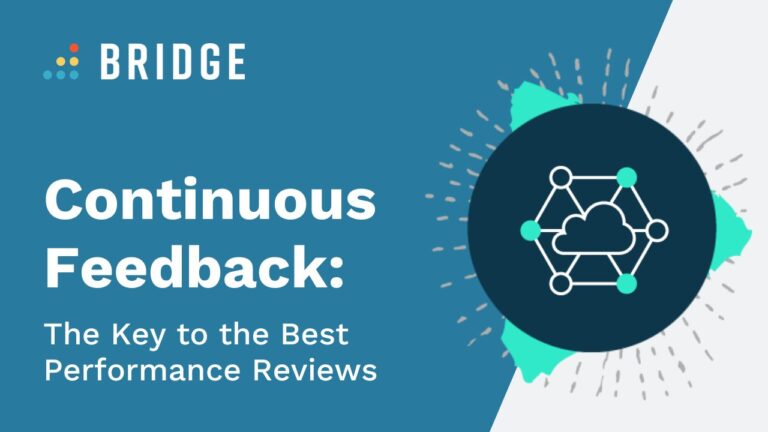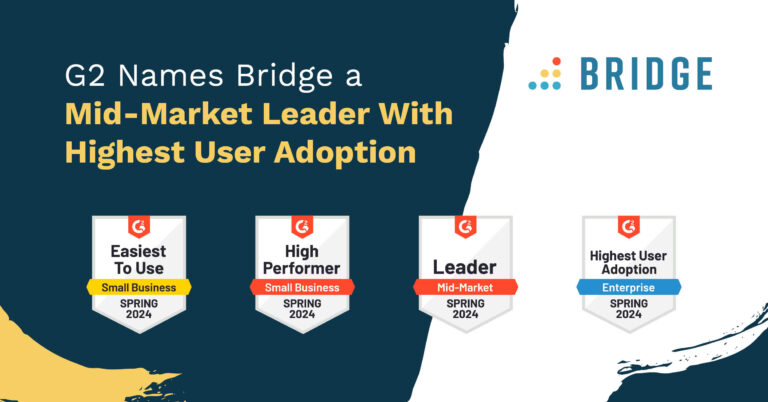At heart, continuous feedback (in which employee feedback is delivered more frequently than the once-per-year standard) is a simple concept. However, this powerful upgrade to your performance management game plan is about more than just scheduling a few extra employee-manager meetings. It’s about making those extra meetings count.
Gartner research has found that only 48% of employees receive useful or actionable feedback—which is a great reminder that your continuous feedback needs to be fruitful as well as frequent.
Good continuous feedback offers your employees a variety of perspectives, topics, and formats to realize the full range of advantages that consistent input brings to your people and your organization. It also bolsters your performance reviews by giving managers a more detailed and even-handed view of employee progress
So, what does a healthy variety of continuous feedback types look like? Read on to find out.
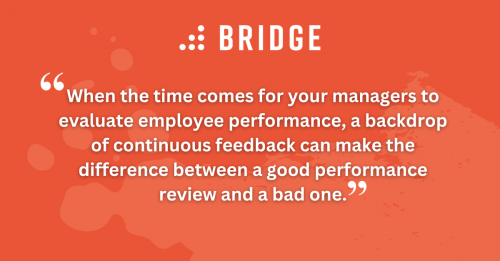
What Are the Performance Review Benefits of Continuous Feedback?
When the time comes for your managers to evaluate employee performance, a backdrop of continuous feedback can make the difference between a good performance review and a bad one.
A bad review—one which is considered unfair, conducted by unprepared managers, or prone to recency bias—can have a range of negative outcomes. At best, it’ll result in a loss of morale. At worst, it could lead to employees quitting.
Embracing continuous feedback allows your managers to deftly sidestep these pitfalls in the performance review process. When your managers are staying up to date on the week-by-week events of their employees’ working lives, they’ll be in a prime position to reflect on the year’s job performance in a fair and well-rounded way.
The familiarity that comes hand-in-hand with regular manager-employee conversations means that there’s no need to latch onto the most recent event, base opinions on misremembered facts, or even feel unsure about a given individual’s contributions. Instead, your managers will have a detailed and long-established understanding of how their reports are getting on.
Better yet, your managers will hopefully be in a position to deliver positive reviews—because any performance issues will likely be picked up, discussed, and addressed during their year-round employee conversations.
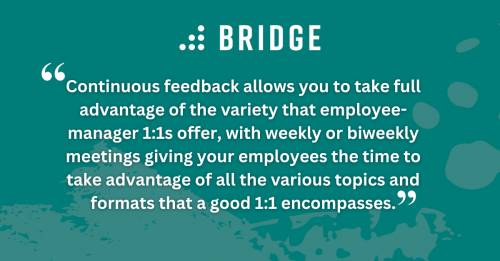
What Are the 4 Types of Continuous Feedback?
Broadly speaking, any form of feedback can be continuous—as long as you’re prepared to offer it frequently. In practice, however, some methods better lend themselves to a continuous feedback model. After all, you’re unlikely to have much to say to an employee on their third comprehensive performance review of the month!
That’s why we’ve whittled the options down to four key types of continuous feedback. A good mixture will ensure that your people are supported on all sides through a combination of manager check-ins, peer-to-peer assessments, periods of self-reflection, and positive reinforcement.
1) 1:1 Manager Check-Ins
Employee-manager 1:1s are likely to be the bread and butter of any continuous feedback program due to the sheer versatility they offer.
Delivered within the space of a single hour or half-hour, a 1:1 can take the form of:
- A mentorship or coaching session in which managers offer advice on employee growth and development
- A means of providing practical support on day-to-day issues that arise in the working lives of your employees
- A safe space for sharing worries, fears, or frustrations with someone potentially capable of solving those problems
- A friendly chat in which managers and employees can forge closer bonds and develop a relationship based on trust, familiarity, and mutual respect
Continuous feedback allows you to take full advantage of the variety that employee-manager 1:1s offer, with weekly or biweekly meetings giving your employees the time to take advantage of all the various topics and formats that a good 1:1 encompasses.
MAKE YOUR CHECK-INS MORE MEANINGFUL | ‘Unlock Your Employees’ Potential With People-First Managers’
2) Peer Feedback
It’s easy to assume that the effects of feedback—especially positive feedback or any recognition of good performance—are at their most potent when delivered by managers. After all, managers are in a better position to offer tangible rewards like promotions, bonuses, or salary increases. In practice, however, that’s not necessarily the case.
For one thing, the monetary rewards that some leaders have the power to grant aren’t the most compelling motivators for many employees. The 2022 Pulse of the American Worker Survey found, for example, that among workers who switched jobs over that period, 46% prioritized their mental health over their careers, while 56% looked for a stable working environment over salary and benefits.
For another thing, it’s been shown that employees value sincerity and authenticity in their professional environments, with one study finding that burnout can be reduced when workers believe their organization’s safety-related policies were sincerely meant.
While managers absolutely can “demonstrate care and concern for employees through personal actions,” as the study points out, feedback may well be perceived as more sincere when it’s given by peers. Your employees’ colleagues have an in-depth understanding of the specific challenges they face in their daily work, and recognition of climbing those barriers is more powerful coming from someone who knows from experience just how high they are.
From a continuous feedback perspective, peer-to-peer assessments are a fantastic proposition. Your employees are likely to interact with peers more regularly than managers, so the feedback they give may well be comprehensive and accurate, while these frequent interactions make it easier to schedule your verbal peer feedback sessions.
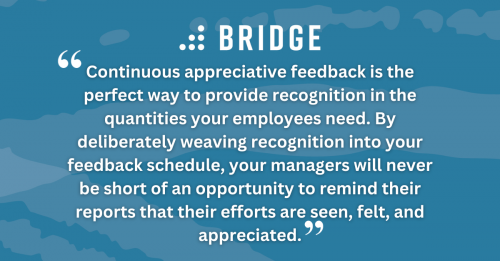
3) Self-Evaluations
A continuous feedback strategy gives you the opportunity to invite employee feedback from an array of different stakeholders—including your employees themselves!
Obviously, a self-assessment can’t be the only weapon in your feedback arsenal—but it can be a great way to put employees in the driving seat when it comes to their professional growth.
This is especially important in a continuous feedback context. Receiving manager-led feedback can feel like a daunting prospect, especially when 33% of workers report an increase in anxiety surrounding in-person meetings, while 64% of young workers experience webcam exhaustion due to online meetings. Ramping up the frequency of your feedback could inadvertently magnify any self-consciousness or anxiety that your people may feel as you implement a continuous model.
By allowing your managers to be informed by self-feedback, however, you’ll give your employees the agency to direct the flow of any other feedback conversations in a way that feels comfortable and appropriate, while ensuring a percentage of your continuous feedback sessions don’t require meetings (or any form of interaction, for that matter!).
It’s worth bearing in mind that, unlike an annual review, your continuous self-assessments will be fairly regular events—so, rather than focusing on questions about long-term objectives or achievements, you’ll benefit from asking employees to reflect on their day-to-day performance. Consider questions like:
- What have you done well in the last month?
- How have you progressed toward your development goals in the last few weeks?
- Have any recent changes impacted your ability to work at your best?
FURTHER READING TO HELP YOUR PEOPLE DEFINE THEIR DEVELOPMENT | ‘What Are SMARTER Goals and How Do They Help Measure Employee Productivity?’
4) Recognition Feedback
While praise, as mentioned above, should absolutely form part of your standard manager 1:1s and peer feedback sessions, there’s a strong case to be made for formally incorporating appreciation and recognition into your continuous feedback cycle. Gartner has found employees work harder if they feel valued. But, for many workers, that’s a big “if”.
In fact, according to The 2022 UK Employee Recognition Survey, over 70% of employees surveyed across 133 businesses felt they deserved more recognition than they received over the preceding year.
It’s worth highlighting the phrasing involved here. The survey respondents didn’t want more vigorous recognition or for their recognition to be broadcast louder—they just wanted more of it!
Continuous appreciative feedback is the perfect way to provide recognition in the quantities your employees need. By deliberately weaving recognition into your feedback schedule, your managers will never be short of an opportunity to remind their reports that their efforts are seen, felt, and appreciated—even against the backdrop of your organization’s busy day-to-day.
LEARN HOW TO MAINTAIN HIGH MORALE | ‘How Connecting With Employees Helps Strengthen Organizational Resilience’
The Power of Feedback Variety
Though it’s possible to split continuous feedback into types or categories, the beauty of increasing the volumes of feedback you offer is that you can mix and match.
A good continuous feedback program will involve a healthy variety of 1:1 check-ins, skills feedback, peer-to-peer sessions, and self-evaluations. This variety of expertise and perspectives will ensure that your people get the most well-rounded advice possible. In fact, continuous feedback makes it easy for employees to grow and develop—and the positive mindset they’ll adopt as their organization remains on hand for support, advice, and encouragement can be particularly powerful.
Looking for More Continuous Feedback Insights?
Then you’ll be pleased to hear we’ve prepared a whole ebook on that very topic. This blog post was just a taste of ‘Feel the Benefits of Continuous Feedback With These 4 Approaches.’ For our full feedback guide, download the ebook below.
